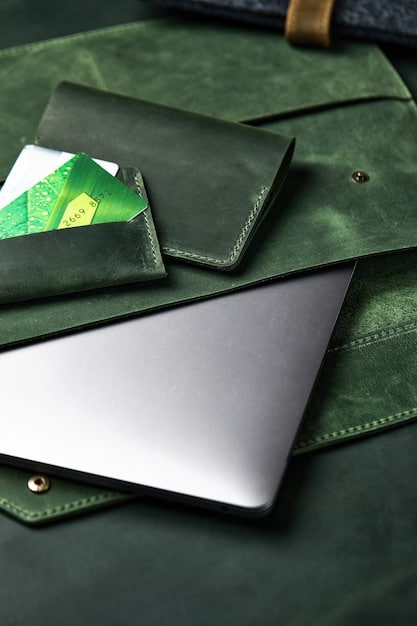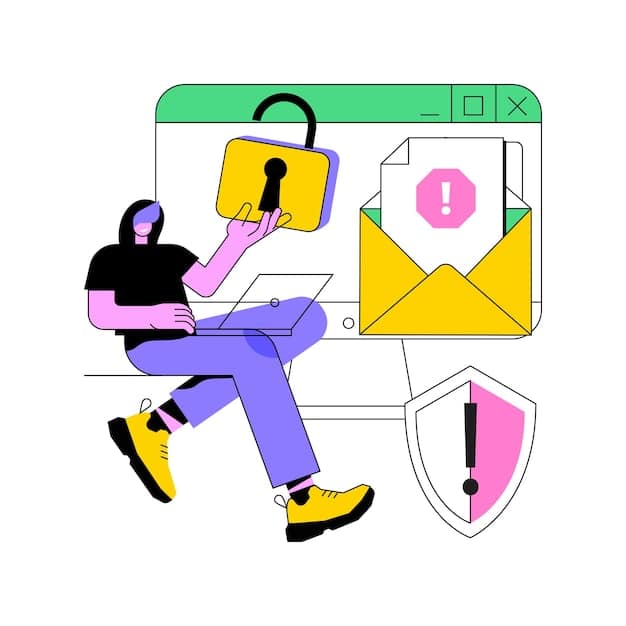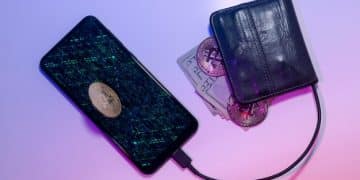Secure Your Crypto: A US Investor’s Wallet Protection Guide

Securing your cryptocurrency wallet is crucial for US investors, involving steps like choosing secure wallets, enabling two-factor authentication, using strong passwords, and keeping software updated to prevent potential losses from theft or scams.
Investing in cryptocurrency can be exciting, but it’s essential to protect your digital assets. This guide provides a step-by-step approach for US investors on how to secure your cryptocurrency wallet: a step-by-step guide for US investors to prevent losses, minimizing risk and ensuring peace of mind. We’ll explore various security measures and best practices you can implement today.
Understanding Cryptocurrency Wallets and Their Risks
Before diving into specific security measures, it’s important to understand what cryptocurrency wallets are and the potential risks associated with them. These risks are often targeted at US investors.
A cryptocurrency wallet is essentially a digital tool that allows you to store, send, and receive digital currencies like Bitcoin, Ethereum, and others. It doesn’t actually hold the coins themselves; instead, it securely stores the private keys necessary to access and manage your cryptocurrency on the blockchain.
Types of Cryptocurrency Wallets
There are several types of crypto wallets, each with different levels of security and convenience:
- Hardware Wallets: Physical devices that store your private keys offline, offering the highest level of security. They are often referred to as “cold storage.”
- Software Wallets: Applications installed on your computer or smartphone, providing easy access to your crypto. These can be desktop, mobile, or web-based.
- Exchange Wallets: Wallets provided by cryptocurrency exchanges. While convenient for trading, they are generally considered less secure as you don’t have full control of your private keys.
- Paper Wallets: A printed copy of your public and private keys. While secure when stored correctly, they are vulnerable to physical damage or theft.

Common Cryptocurrency Wallet Risks
Cryptocurrency wallets are vulnerable to several risks, especially if security measures are not properly implemented:
- Hacking: Online wallets are susceptible to hacking attempts, where malicious actors try to gain unauthorized access to your funds.
- Phishing: Scammers often use fake emails or websites to trick you into revealing your private keys or login credentials.
- Malware: Viruses and other malicious software can steal your private keys or compromise your wallet’s security.
- Loss of Private Keys: If you lose your private keys or seed phrase, you lose access to your cryptocurrency.
The risks associated with cryptocurrency wallets can be daunting. By understanding these risks and the different types of wallets available, you can make informed decisions to safeguard your digital assets.
Choosing the Right Cryptocurrency Wallet for Your Needs
Selecting the right cryptocurrency wallet is the first step in securing your digital assets. The best choice depends on your individual needs, trading frequency, and risk tolerance. Choosing a wallet that aligns with your requirements is vital.
Consider factors like the level of security offered, ease of use, supported cryptocurrencies, and reputation of the wallet provider. Research different wallets and read reviews before making a decision.
Factors to Consider When Choosing a Wallet
Here are some key factors to consider when choosing a cryptocurrency wallet:
- Security: Prioritize wallets that offer robust security features like two-factor authentication (2FA), multi-signature support, and cold storage options.
- Control of Private Keys: Opt for wallets that give you full control of your private keys. This means you are responsible for securing them, but you also have complete ownership of your cryptocurrency.
- Supported Cryptocurrencies: Ensure the wallet supports the cryptocurrencies you plan to store. Not all wallets support every cryptocurrency.
Choosing a wallet is a critical step in cryptocurrency investing. By carefully evaluating these factors and selecting a wallet that meets your requirements, you can lay a strong foundation for securing your digital assets.
Setting Up Your Cryptocurrency Wallet Securely
Once you’ve chosen a cryptocurrency wallet, setting it up securely is crucial to protecting your assets. This process involves creating strong passwords, enabling two-factor authentication, and backing up your wallet.
Follow the wallet provider’s instructions carefully and take extra precautions to ensure your wallet is configured for maximum security. Treat this step with utmost importance.
Creating Strong Passwords
A strong password is your first line of defense against unauthorized access to your wallet. Use a unique and complex password that is difficult to guess.
- Use a Combination of Characters: Include uppercase and lowercase letters, numbers, and symbols.
- Avoid Personal Information: Don’t use your name, birthday, or other easily guessable information.
Enabling Two-Factor Authentication (2FA)
Two-factor authentication adds an extra layer of security to your wallet by requiring a second verification method in addition to your password. This can be a code sent to your phone, a biometric scan, or a hardware security key.
This extra layer prevents unauthorized access even if someone knows your password. It’s an essential security measure for protecting your cryptocurrency wallet. The second factor substantially reduces the risk of breaches.
Implementing Advanced Security Measures for US Investors
Beyond the basic setup, US investors should consider implementing advanced security measures to further protect their cryptocurrency wallets. These measures include using a Virtual Private Network (VPN), securing your email account, and being wary of phishing attempts.
These advanced measures provide additional layers of security. Implementing these safeguards dramatically mitigates the possibility of cyber threats.
Using a Virtual Private Network (VPN)
A VPN encrypts your internet traffic and masks your IP address, making it more difficult for hackers to intercept your data or track your online activity. Using a VPN is especially important when accessing your cryptocurrency wallet on public Wi-Fi networks.
It’s a robust line of defense when you’re handling sensitive financial information. A VPN ensures that your cryptocurrency transactions remain private and secure, particularly when you’re on the go.
Securing Your Email Account
Your email account is often linked to your cryptocurrency wallet and other online accounts. Securing your email account with a strong password and two-factor authentication is critical to preventing unauthorized access.

- Use a Strong, Unique Password: Ensure your email password is different from your other passwords.
- Enable Two-Factor Authentication: Protect your email with 2FA to further secure your account.
- Be Wary of Phishing Emails: Double-check the sender’s address before clicking any links or providing any information.
These email protections are essential. By keeping your email secure, you protect a pivotal access point.
Staying Informed and Updated on Cryptocurrency Security
The cryptocurrency landscape is constantly evolving, and new security threats emerge regularly. Staying informed and updated on the latest security best practices is crucial for protecting your digital assets.
Be proactive about learning about new threats and vulnerabilities. This knowledge will help you make informed decisions about your security measures. US investors can significantly strengthen their wallet protection posture.
Following Cryptocurrency Security News
Stay up-to-date on the latest cryptocurrency security news and trends by following reputable news sources, security blogs, and social media accounts. This will help you identify potential threats and vulnerabilities early on.
- Read Reputable News Sources: Stay informed about the latest security threats and vulnerabilities.
Updating Your Software and Wallets
Regularly update your software and wallets to the latest versions. These updates often include security patches and bug fixes that can protect your wallet from known vulnerabilities.
- Enable Automatic Updates: Configure your software and wallets to automatically update to the latest versions.
Being proactive and informed is key. Staying updated on cryptocurrency security trends will empower you to adapt your security measures and maintain a strong defense against emerging threats. This proactive approach is essential for any US investor serious about protecting their cryptocurrency investments.
Recovering Your Cryptocurrency Wallet in Case of Loss or Theft
Even with the best security measures in place, there is always a risk of losing access to your cryptocurrency wallet through theft, loss, or damage. Knowing how to recover your wallet in such situations is crucial to retrieving your digital assets.
The recovery process depends on the type of wallet. Hardware wallets use seed phrases, while software wallets may have backup options. Understand these procedures beforehand to prevent irreparable losses.
Using Seed Phrases for Recovery
Most hardware wallets provide a seed phrase, which is a set of 12 or 24 words that can be used to recover your wallet if it is lost or stolen. Store your seed phrase securely offline, away from your wallet.
Do not store this sensitive recovery code digitally. Secure it physically, ideally in more than one secure location. This way you can rest assured that your crypto is recoverable through these methods.
Utilizing Backup Options for Software Wallets
Software wallets often offer backup options that allow you to restore your wallet to a new device if your old one is lost or damaged. Follow the wallet provider’s instructions carefully when creating a backup.
It’s like having a safety net. Regularly back up your software wallet, as the ability to restore your digital assets can be extremely valuable.
| Key Point | Brief Description |
|---|---|
| 🔐 Wallet Choice | Choose a wallet type based on your security needs and usage. |
| 🛡️ 2FA Enablement | Activate two-factor authentication for extra security. |
| 🔑 Secure Password | Use strong, unique passwords for your wallet and email. |
| 🌐 VPN Usage | Use a VPN to encrypt your internet traffic, especially on public Wi-Fi. |
Frequently Asked Questions (FAQ)
▼
A cryptocurrency wallet is a digital tool used to store, send, and receive cryptocurrencies. It securely holds your private keys, enabling you to access and manage your crypto assets on the blockchain.
▼
Consider security features like 2FA and cold storage. Also, verify that the wallet supports your crypto and offers control over private keys. Read user reviews before choosing a wallet.
▼
Two-factor authentication adds an extra layer of security, requiring a second verification method besides your password. This prevents unauthorized access, even if your password is compromised somehow.
▼
If you lose your wallet, use your seed phrase or backup to restore it. Report any theft if there was foul play. Always keep your recovery information safe and secure.
▼
Update your cryptocurrency wallet regularly to ensure you have the latest security patches and features. Enable automatic updates if available to make the process seamless and consistent at all times.
Conclusion
Securing your cryptocurrency wallet involves a multi-faceted approach, from choosing the right wallet and setting it up securely to staying informed and implementing advanced security measures. By following these steps, US investors can significantly reduce the risk of losing their digital assets and enjoy the benefits of cryptocurrency investing with greater confidence.





